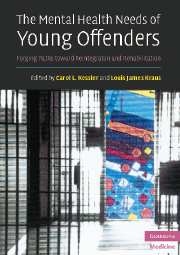Book contents
- Frontmatter
- Contents
- List of contributors
- Foreword
- Acknowledgments
- 1 An overview of child and adolescent mental health needs in the juvenile justice system
- 2 Psychiatric disorders of youth in detention
- 3 Disproportionate minority confinement
- 4 Police interrogation of youth
- 5 Assessing children's competence to stand trial and to waive Miranda rights: new directions for legal and medical decision-making in juvenile courts
- 6 The etiology of antisocial behavior: biopsychosocial risk factors across development
- 7 Substance abuse in youth offenders
- 8 Suicide and delinquent adolescents
- 9 Juvenile sex offenders
- 10 Educational needs of youth in the juvenile justice system
- 11 Science and the juvenile death penalty
- 12 Medical issues regarding incarcerated adolescents
- 13 Mental health screening and assessment in juvenile justice
- 14 Psychological testing in juvenile justice settings
- 15 Psychopharmacology and juvenile delinquency
- 16 Evidence-based treatment for justice-involved youth
- 17 Community alternatives to incarceration
- 18 Innovative problem-solving court models for justice-involved youth
- 19 Ethical issues of youthful offenders: confidentiality; right to receive and to refuse treatment; seclusion and restraint
- 20 Post-adjudicatory assessment of youth
- Index
- References
13 - Mental health screening and assessment in juvenile justice
Published online by Cambridge University Press: 11 August 2009
- Frontmatter
- Contents
- List of contributors
- Foreword
- Acknowledgments
- 1 An overview of child and adolescent mental health needs in the juvenile justice system
- 2 Psychiatric disorders of youth in detention
- 3 Disproportionate minority confinement
- 4 Police interrogation of youth
- 5 Assessing children's competence to stand trial and to waive Miranda rights: new directions for legal and medical decision-making in juvenile courts
- 6 The etiology of antisocial behavior: biopsychosocial risk factors across development
- 7 Substance abuse in youth offenders
- 8 Suicide and delinquent adolescents
- 9 Juvenile sex offenders
- 10 Educational needs of youth in the juvenile justice system
- 11 Science and the juvenile death penalty
- 12 Medical issues regarding incarcerated adolescents
- 13 Mental health screening and assessment in juvenile justice
- 14 Psychological testing in juvenile justice settings
- 15 Psychopharmacology and juvenile delinquency
- 16 Evidence-based treatment for justice-involved youth
- 17 Community alternatives to incarceration
- 18 Innovative problem-solving court models for justice-involved youth
- 19 Ethical issues of youthful offenders: confidentiality; right to receive and to refuse treatment; seclusion and restraint
- 20 Post-adjudicatory assessment of youth
- Index
- References
Summary
Mental health screening in juvenile justice
Over 106 000 youths are in the custody of juvenile justice facilities in the US daily (Synder & Sickmund, 1999). Recent estimates suggest that nearly 60 percent of boys and over two-thirds of girls involved with the juvenile justice system meet criteria for one or more psychiatric disorders, even after controlling for conduct disorder (Teplin et al., 2002). These prevalence rates are higher than those found in youth in the general population (around 14–22 percent; e.g., Kazdin, 2000; Rutter, 1989) and substantially higher than adult prisoners in areas where such comparisons can be made. For example, 13 percent of male delinquents (Teplin et al., 2002) would meet criteria for major depression in contrast to only 4 percent of male adult offenders (Teplin, 1994).
In light of these statistics, accurate identification of mental, behavioral, and emotional disturbances that require immediate attention; namely, risk of suicide or self-harm, risk of aggression, or a pressing mental disorder, is essential as youths enter the juvenile justice system. State juvenile justice facilities have a legal and moral responsibility to respond to the mental health needs of adolescents in their custody (Grisso, 2004). When youths are identified as having a high potential for serious mental health issues, it allows staff to respond immediately to these needs by making appropriate placement decisions in the institution or by referring the youth for a clinical evaluation.
Keywords
- Type
- Chapter
- Information
- The Mental Health Needs of Young OffendersForging Paths toward Reintegration and Rehabilitation, pp. 270 - 287Publisher: Cambridge University PressPrint publication year: 2007
References
- 3
- Cited by



